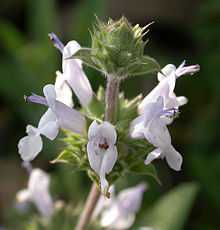Salvia mellifera
| Salvia mellifera | |
|---|---|
 | |
| Scientific classification | |
| Kingdom: | Plantae |
| (unranked): | Angiosperms |
| (unranked): | Eudicots |
| (unranked): | Asterids |
| Order: | Lamiales |
| Family: | Lamiaceae |
| Genus: | Salvia |
| Species: | S. mellifera |
| Binomial name | |
| Salvia mellifera Greene | |
Salvia mellifera (Black sage) is a small, highly aromatic, evergreen shrub of the genus Salvia (the sages) native to California, and Baja California, Mexico. It is common in the coastal sage scrub of Southern California and northern Baja California.[1] Black sage has a dark appearance, especially during drought.
Description
Black sage is a perennial shrub that grows approximately 1–2 meters (3–6 ft) tall. It is covered with simple hairs with some glandular hairs, which makes it highly aromatic. The leaves are oblong-elliptic to obovate in shape and are about 2.5–7 cm (1–2.8 in) long. The upper surface of the leaf is somewhat glabrous, while the lower surface of the leaf is hairy.[1]
The inflorescence occurs in 1.6–4 cm (0.6–1.6 in) -wide clusters. The flowers are usually a pale blue or lavender color, and rarely a pale rose color. The upper lip of the flower is 2-lobed. The style and stamens are slightly exserted. The fruit produced by the black sage is a schizocarp composed of four 2–3 mm (0.08–0.12 in) brown nutlets.[1]
Ecology
Black sage grows in the coastal sage scrub and lower chaparral plant communities. It occurs from sea level to 1200 m (3900 ft) elevation.[1] Black sage is able to grow on a variety of different soils, including sandstone, shale, granite, serpentinite, and gabbro or basalt. It is semi-deciduous, depending on the location and severity of drought, shallow rooted, and drought tolerant by leaf curling rather than drought-avoiding through leaf drop.
Black sage readily hybridizes with three other coastal scrub Salvias: Salvia apiana (white sage), Salvia leucophylla, and Salvia clevelandii. It rarely hybridizes with the annuals Salvia columbariae and Salvia carduacea.[2]
Traditional use
The Chumash people used a strong sun tea of the leaves and stems of the plant. This was rubbed on the painful area or used to soak one's feet. The plant contains diterpenoids, such as aethiopinone and ursolic acid, that are pain relievers.[3]
The Black Sage also produces a nectar that Black Sage honey is made from. This honey is typically peppery and strong, and is prized as a rare honey due to the plant's dry climate. Black Sage honey can only be made when specific rain conditions are met and the plant produces enough nectar.
See also
Notes
- ↑ 1.0 1.1 1.2 1.3 Jepson Flora Project "S. mellifera Greene Black Sage". Jepson Manual. University of California. 1993. Retrieved 2009-04-12.
- ↑ Montalvo, Arlee M.; McMillan, Paul A. "Salvia mellifera Greene LAMIACEAE". U. S. Forest Service. Retrieved 24 April 2012.
- ↑ "Palliative Care Among Chumash People" (PDF). Wild Food Plants. Archived from the original on 2007-10-06. Retrieved 2007-07-14.
External links
| Wikimedia Commons has media related to Salvia mellifera. |
- USDA Forest Service: SPECIES: Salvia mellifera
- USDA Natural Resources Conservation Treatment: Salvia mellifera
- Jepson Flora Project – Salvia mellifera